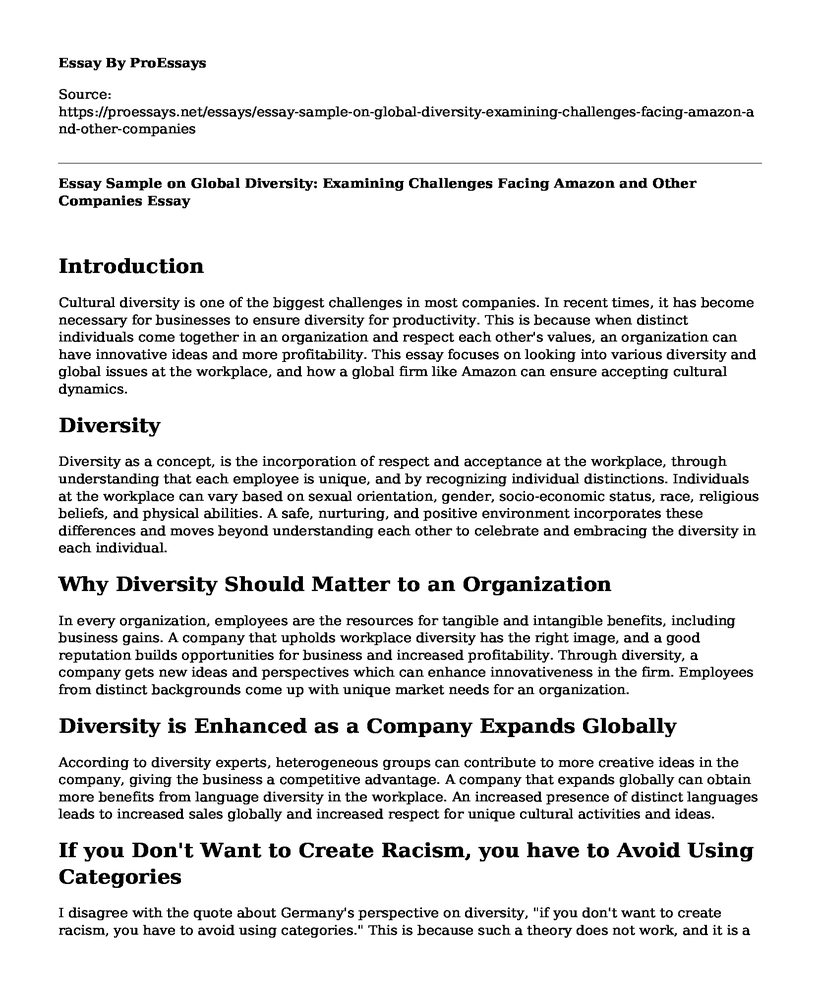Introduction
Cultural diversity is one of the biggest challenges in most companies. In recent times, it has become necessary for businesses to ensure diversity for productivity. This is because when distinct individuals come together in an organization and respect each other's values, an organization can have innovative ideas and more profitability. This essay focuses on looking into various diversity and global issues at the workplace, and how a global firm like Amazon can ensure accepting cultural dynamics.
Diversity
Diversity as a concept, is the incorporation of respect and acceptance at the workplace, through understanding that each employee is unique, and by recognizing individual distinctions. Individuals at the workplace can vary based on sexual orientation, gender, socio-economic status, race, religious beliefs, and physical abilities. A safe, nurturing, and positive environment incorporates these differences and moves beyond understanding each other to celebrate and embracing the diversity in each individual.
Why Diversity Should Matter to an Organization
In every organization, employees are the resources for tangible and intangible benefits, including business gains. A company that upholds workplace diversity has the right image, and a good reputation builds opportunities for business and increased profitability. Through diversity, a company gets new ideas and perspectives which can enhance innovativeness in the firm. Employees from distinct backgrounds come up with unique market needs for an organization.
Diversity is Enhanced as a Company Expands Globally
According to diversity experts, heterogeneous groups can contribute to more creative ideas in the company, giving the business a competitive advantage. A company that expands globally can obtain more benefits from language diversity in the workplace. An increased presence of distinct languages leads to increased sales globally and increased respect for unique cultural activities and ideas.
If you Don't Want to Create Racism, you have to Avoid Using Categories
I disagree with the quote about Germany's perspective on diversity, "if you don't want to create racism, you have to avoid using categories." This is because such a theory does not work, and it is a way of ignoring the minority groups and acting like they do not exist. The approach can not work in the United States since the country aims at boosting equality and acknowledges that there are racial issues. In the United States, the focus is on the discrimination that exists in the communities of color on matters like unemployment, policing, and lack of proper education. In Germany, people of color do not live, and there is no need to keep them in mind, a situation that has ignored the needs of the minority groups.
How a Union can Affect a Corporate Culture
I think Unions can present challenges to the culture of an organization and its changes. Studies suggest that Unions create cultural dynamics that generate problems to how an organization functions effectively, which can be hard to alter. Most Unions have a varied culture as compared to the non-union groups, and the nature of the cultural variation creates a cultural gap between union and non-unions, and hence a fault line in the overall organizational culture. The fault line, in this case, is the factors including; conflicts and distinctions in characteristics of people, labor-management relations, and the different contexts in jobs and work. Unions, due to these factors, reduce empowerment, create less effective teamwork, and hardly support any career development and advancement within the organization.
Ethnocentric Companies Employ Xenophobic Employees
Ethnocentric companies indeed hire xenophobic employees. Xenophobic employees have the fear and hatred of foreigners and strangers and anything foreign and strange. Ethnocentric individuals contain behaviors and attitudes towards their members, through considering them to be moral, they look backward on other people, by believing that their group of people is more superior than others. Ethnocentric companies believe that there are some areas that this action is relevant, mostly in marketing decisions and global human resources. The core focus of a company like Amazon is that an inter-cultural aspect is the forefront of global business analysis, implying that cultural determinants regulate how individuals interact between cultural entities. Since ethnocentric behavior in a global firm like Amazon is an issue that affects all areas of its global management, the company can ensure an accepting culture dynamic at work by structuring jobs clearly in the host country through developing clear job responsibilities. Amazon should also incorporate local employees into their strategic decisions and ensure the facilitation of communication in international divisions.
Conclusion
Rather than disregarding minority groups, workplaces should utilize differences to expand their employee skills. Most organizations and businesses have had a hard time generating positive diversity since minority groups usually feel left out in strategic decision making in the companies. Any organization should make it a priority, improving and selecting all populations and not just a particular group of people to run their activities. Diversity ensures that customers respect an organization since it caters to the needs of everyone.
Cite this page
Essay Sample on Global Diversity: Examining Challenges Facing Amazon and Other Companies. (2023, Mar 25). Retrieved from https://proessays.net/essays/essay-sample-on-global-diversity-examining-challenges-facing-amazon-and-other-companies
If you are the original author of this essay and no longer wish to have it published on the ProEssays website, please click below to request its removal:
- Article Analysis Essay on Gender Role of Family in Small Village and Big Cities in India
- Reinforcing New Behaviours Case Study
- How Technology Has Changed the Work Place - Paper Example
- Cultural Differences in Marriage Essay Example
- Research Paper on Outsourcing for Long-Term Care Facilities: Benefits & Considerations
- Essay Example on HRM: Essential Role in Admin, Empowerment & Strategic Positioning
- Paper Example on Marriage & Family Therapists Help Elderly & Families Manage Aging Transitions







